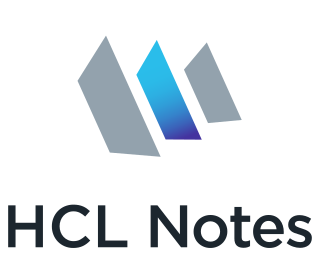
Electronic mail is a method of transmitting and receiving messages using electronic devices. It was conceived in the late–20th century as the digital version of, or counterpart to, mail. Email is a ubiquitous and very widely used communication medium; in current use, an email address is often treated as a basic and necessary part of many processes in business, commerce, government, education, entertainment, and other spheres of daily life in most countries.

HCL Notes is a proprietary collaborative software platform for Unix, Windows, Linux and macOS, sold by HCLTech. The client application is called Notes while the server component is branded HCL Domino.

Webmail is an email service that can be accessed using a standard web browser. It contrasts with email service accessible through a specialised email client software. Additionally, many internet service providers (ISP) provide webmail as part of their internet service package. Similarly, some web hosting providers also provide webmail as a part of their hosting package.
The Melissa virus is a mass-mailing macro virus released on or around March 26, 1999. It targets Microsoft Word and Outlook-based systems and created considerable network traffic. The virus infects computers via email; the email is titled "Important Message From," followed by the current username. Upon clicking the message, the body reads, "Here's that document you asked for. Don't show anyone else ;)." Attached is a Word document titled "list.doc," containing a list of pornographic sites and accompanying logins for each. It then mass-mails itself to the first fifty people in the user's contact list and disables multiple safeguard features on Microsoft Word and Microsoft Outlook.

Microsoft Outlook is a personal information manager software system from Microsoft, available as a part of the Microsoft 365 software suites. Though primarily being popular as an email client for businesses, Outlook also includes functions such as calendaring, task managing, contact managing, note-taking, journal logging, web browsing, and RSS news aggregation.

Outlook Express, formerly known as Microsoft Internet Mail and News, is a discontinued email and news client included with Internet Explorer versions 3.0 through 6.0. As such, it was bundled with several versions of Microsoft Windows, from Windows 98 to Windows Server 2003, and was available for Windows 3.x, Windows NT 3.51, Windows 95, Mac System 7, Mac OS 8, and Mac OS 9. In Windows Vista, Outlook Express was superseded by Windows Mail.

ZDNET is a business technology news website owned and operated by Red Ventures. The brand was founded on April 1, 1991, as a general interest technology portal from Ziff Davis and evolved into an enterprise IT-focused online publication.

The Bat! is an email client for the Microsoft Windows operating system, developed by Moldovan software company Ritlabs. It is sold as shareware and offered in three editions: Home Edition, Professional Edition, and Voyager which is a portable version and is included with Professional Edition.
The following tables compare general and technical features of notable email client programs.
OfficeVision was an IBM proprietary office support application.
HCL iNotes offers a full-featured web-based version of HCL Technologies's HCL Notes client. Formerly known as IBM Lotus Domino Web Access, HCL iNotes provides HCL Notes users with browser-based access to their HCL Notes mail, calendar, and contacts. The software combines with HCL Domino software to provide a client interface that is available both online and offline. It provides access to collaboration tools using a variety of Web browsers across multiple platforms.

J2 Global, Inc. was an American technology holding company based in Los Angeles, California. The company provided Internet services through two divisions: Business Cloud Services and Digital Media.
The comparison of mail servers covers mail transfer agents (MTAs), mail delivery agents, and other computer software that provide e-mail services.
Bynari is a defunct company based in Dallas, developing server and email software, mainly known for its Insight Family, similar to Microsoft Exchange Server with Outlook.

IBM Lotus Symphony is a discontinued suite of applications for creating, editing, and sharing text, spreadsheet, presentations, and other documents and browsing the World Wide Web. It was first distributed as commercial proprietary software, then as freeware, before IBM contributed the suite to the Apache Software Foundation in 2014 for inclusion in the free and open-source Apache OpenOffice software suite.
Courier was an email client for Microsoft Windows. The software was originally released in 1996 as Calypso by Micro Computer Systems (MCS).

Outlook.com, formerly Hotmail, is a free personal email service offered by Microsoft. This includes a webmail interface featuring mail, calendaring, contacts, and tasks services. Outlook can also be accessed via email clients using the IMAP or POP protocols.

Zarafa was an open-source groupware application that originated in the city of Delft in the Netherlands. The company that developed Zarafa, previously known as Connectux, is also called Zarafa. The Zarafa groupware provided email storage on the server side and offered its own Ajax-based mail client called WebAccess and a HTML5-based, WebApp. Advanced features were available in commercially supported versions. Zarafa has been superseded by Kopano.
IBM Notes Traveler is a software, a push-email product which provides access to email and Personal Information Management (PIM) application for IBM Notes customers using supported mobile devices. Version 9.0 supports Android 2.x, 3.x, and 4.x; Apple iPhone and iPad; Microsoft Windows Mobile 5 and 6; Windows Phone 7 and 8; Windows RT; Blackberry 10; and Symbian Series 60 mobile platforms as well as Microsoft Outlook and Windows 8 desktop platforms.

Marcus J. Ranum is a computer and network security researcher. He is credited with a number of innovations in firewalls, including building the first Internet email server for the whitehouse.gov domain, and intrusion detection systems. He has held technical and leadership positions with a number of computer security companies, and is a faculty member of the Institute for Applied Network Security.











